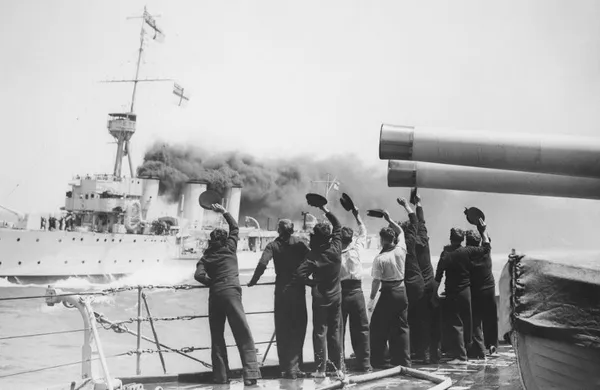Eye For Film >> Movies >> The Battles of Coronel And Falkland Islands (1927) Film Review
The Battles of Coronel And Falkland Islands
Reviewed by: Donald Munro

There were surprisingly few naval battles during World War I, especially as control of the high seas was one of the strategic imperatives that drove many of the major powers to war. For Britain the growing German fleet was a threat to its stranglehold on world trade. The British Empire using its strategic fleets to control trade was a problem for other empires. Russia saw its lack of a viable deep water port as crippling, with the ice bound Vladivostok not one of the most useful ports in the world. In 1904 it had fought the disastrous Russo-Japanese war in a vain attempt to control Lüshun (Port Arthur). The Battles Of Coronel And Falkland Islands documents two related naval battles. The first was fought on the first of November 1914 west of the Chilean city of Coronel. The second, related action, on the eighth of December, was to the east of Port Stanley.
The depiction of The Battle of Coronel is truly gripping. Rear Admiral Cradock turns his ships in a suicidal attack on von Spee's force. Huge guns fire, their barrels echelons on screen. Giant sprockets with clashing cogs whirl in steam and smoke as men stoke massive boilers. Great ships wheel around, billowing smoke and crashing through spray. HMS Good Hope and Monmouth, symbols of industrial and imperial power, go to the bottom with all hands as the Glasgow escapes into the night.

When it comes to the Falkland Islands the film, like Spee's fleet, has shot a lot of its ammunition. We see the same guns and sprockets, the same boilers and smoke. Climactically it is a rerun of the first battle. The depiction of panic in Whitehall over Coronel, the need for revenge, and the frantic refitting of the dreadnoughts Invincible and Inflexible don't provide enough space between the battles. The result is that the Battle of Falkland Islands would quickly becomes tedious, but for one thing. Simon Dobson's score meshes beautifully with the onscreen image. The stirring sounds of The Band of Her Majesty’s Royal Marines is blended with horns, struck metal and Russolo-like growling and gratings. Pulsating, it mimics the industrial, the guns and engine rooms and even a smashed piano.
As a piece of propaganda, the film is noteworthy for both a light touch (no baby eating Huns bayoneting pregnant women) and historical accuracy. It showcases the Royal Navy's superiority and promotes the industrial might of the British worker. The rescuing of drowning German seamen and a small dog (a reference to Turpitz the Pig) highlights a sense of fair play. In von Spee the film also features an early version of the archetypal "Good German", the noble and honourable warrior, which can be seen later in depictions of Rommel. It's what the film misses out that is important. It does not touch the debacle with HMS Canopus or on Winston Churchill's involvement in the disaster at Coronel, his influence on Cradock's incomprehensible decision to attack the vastly superior German fleet. Did infighting within the British establishment send 1600 men to their watery graves, the same infighting that resulted in Gallipoli?
The restoration of the film is particularly good with only a few section looking in poor condition. With the addition of the new soundtrack The Battles Of Coronel And Falkland Islands is very watchable and not just a historical curiosity.
Reviewed on: 16 Oct 2014

















